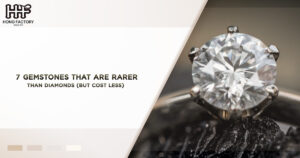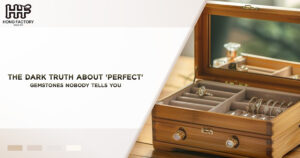When it comes to gemstones, diamonds have traditionally hogged the spotlight, symbolizing wealth, romance, and luxury. However, the world of rare gemstones holds a treasure trove of alternatives that are not only stunning but can also surpass diamonds in value. Often overlooked for their rarity and unique properties, these “boring” gemstones are gems in the truest sense.
Whether you’re a collector, an investor, or simply curious, this guide will introduce you to seven lesser-known but highly valuable gemstones. These natural gems are captivating in their own right, offering a smart alternative for gem investment while breaking away from mainstream trends.
1. Alexandrite – The Magical Color-Changer
Alexandrite is a rare variety of the mineral chrysoberyl, prized for its incredible ability to change color under different lighting. By daylight, it appears green to bluish-green, but under incandescent light, it transforms into a reddish-purple hue. Discovered in Russia’s Ural Mountains in the 1830s, this gemstone is considered one of the rarest and most precious stones in the world.
- Why It’s More Valuable Than Diamonds – The rarity of high-quality alexandrite, combined with its unique optical properties, makes it exceptionally expensive. Fine examples can fetch prices exceeding $10,000 per carat.
- Unique Property – Its dramatic color change is often described as “emerald by day, ruby by night,” making it a fascinating choice for collectors.
2. Paraíba Tourmaline – The Neon Treasure
The Paraíba tourmaline is a vivid gemstone that owes its electric blue, green, or turquoise hue to traces of copper. First discovered in the Brazilian state of Paraíba in the 1980s, it has since become one of the most sought-after gemstones in the world. Due to its extreme rarity, even small stones can command sky-high prices.
- Why It’s More Valuable Than Diamonds – Paraíba tourmalines are far rarer than diamonds, with prices often exceeding $50,000 per carat for top-quality stones.
- Unique Property – Its unmistakable glow, often described as “neon” or “electric,” sets it apart from any other gemstone.
3. Tanzanite – A One-Source Wonder
Tanzanite, a striking blue-violet gemstone, is found exclusively in a small area near Mount Kilimanjaro in Tanzania. Discovered in the 1960s, this stone has quickly gained popularity for its vibrant hue and limited supply.
- Why It’s More Valuable Than Diamonds – Tanzanite’s rarity stems from its single-source origin. Experts predict the mines could be depleted within a few decades, which could drive its value even higher.
- Unique Property – Its pleochroism, which means it can display different colors (blue, violet, and burgundy) depending on the angle of light, makes it a mesmerizing choice.
4. Spinel – The Underrated Beauty
Often mistaken for rubies or sapphires in historical royal jewels, spinel is a gemstone that has only recently gained recognition for its beauty and value. It comes in a variety of colors, including vivid red, pink, and blue.
- Why It’s More Valuable Than Diamonds – While spinel is more affordable in general, rare colors like intense red or cobalt blue can be more expensive than diamonds of equal size and quality.
- Unique Property – Unlike many gemstones, spinel is not treated or enhanced, meaning its vibrant colors are entirely natural.
5. Red Beryl – The Scarlet Rarity
Red beryl, also known as bixbite, is one of the rarest gemstones on Earth. Found primarily in Utah’s Wah Wah Mountains, it is estimated to be 1,000 times rarer than diamonds. Its striking red hue is caused by traces of manganese.
- Why It’s More Valuable Than Diamonds – Due to its extreme rarity, high-quality red beryl can sell for over $10,000 per carat, making it a prized possession among collectors.
- Unique Property – Most red beryl crystals are too small for cutting, so faceted stones are exceptionally rare.
6. Black Opal – The Fiery Dark Horse
Black opal is the rarest and most valuable type of opal, characterized by its dark body tone that enhances the stone’s vibrant play-of-color. Mined primarily in Lightning Ridge, Australia, black opals are a collector’s dream.
- Why It’s More Valuable Than Diamonds – Top-quality black opals can command prices exceeding $15,000 per carat, particularly if they display a vivid and full spectrum of colors.
- Unique Property – Its play-of-color effect, where the stone flashes different colors as it moves, is unparalleled in the gemstone world.
7. Grandidierite – The Exotic Green-Blue Gem
Discovered in Madagascar in the early 20th century, grandidierite is an extremely rare gemstone prized for its deep greenish-blue hue. Its limited availability and unique color make it a coveted find for gemstone enthusiasts.
- Why It’s More Valuable Than Diamonds – Grandidierite is so rare that facetable specimens are almost unheard of, making it highly valuable. Prices for gem-quality stones can reach $20,000 per carat.
- Unique Property – Its strong pleochroism allows it to display three colors—blue, green, and colorless—depending on the viewing angle.
Why These Rare Gemstones Are Worth Exploring
The value of a gemstone is determined by more than just its beauty. Factors like rarity, uniqueness, and demand play a significant role in determining their worth. While diamonds are undoubtedly precious, they are far from the rarest gemstones in existence. Investing in natural gems like those listed above can be a strategic move, as their limited supply often leads to increased value over time.
If you’re considering gem investment, these seven gemstones offer a compelling alternative to diamonds. They not only provide excellent value but also allow you to own something truly unique. Whether it’s the enchanting color change of alexandrite or the neon glow of Paraíba tourmaline, these precious stones are a testament to nature’s artistry.
Tips for Choosing Rare Gemstones
- Verify Authenticity – Always purchase gemstones from reputable dealers. Request certification from recognized gemological laboratories.
- Understand Treatments – Some gemstones are treated to enhance their color or clarity. Natural, untreated stones typically command higher prices.
- Consider Rarity – Rarity directly impacts value. Opt for stones with limited availability, like red beryl or grandidierite.
- Focus on Quality – Factors like color, clarity, cut, and carat weight influence a gemstone’s value. Aim for the best quality your budget allows.
- Think Long-Term – Gem investment is a long-term strategy. Choose stones with the potential for appreciation over time.
Conclusion
While diamonds may be the traditional choice for luxury and investment, the world of rare gemstones offers a wealth of alternatives that are equally, if not more, valuable. From alexandrite’s mesmerizing color change to grandidierite’s exotic allure, these natural gems are a celebration of rarity and beauty.
By exploring lesser-known but precious stones, you can break free from the conventional and embrace something truly extraordinary. Whether for personal enjoyment or as a smart investment, these “boring” gemstones are anything but dull—they’re treasures waiting to be discovered.




